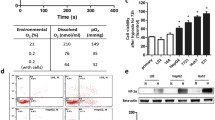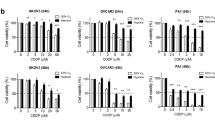Abstract
Rapidly proliferating tumor cells easily become hypoxic. This results in acquired stability towards treatment with anticancer drugs. Here, we show that cells grown at 0.1 % oxygen are more resistant towards treatment with the conventionally used anticancer drugs doxorubicin and cisplatin. The stimulation of apoptosis, as assessed by the number of cells in the SubG1 fraction of the cell cycle, release of cytochrome c into the cytosol, activation of caspase-3, and cleavage of PARP, was markedly suppressed under low oxygen content or when hypoxia was mimicked by deferoxamine. Hypoxia or deferoxamine treatment was accompanied by stabilization of the hypoxia-inducible factor (HIF-1). The downregulation of HIF-1 using siRNA technique restored cell sensitivity to treatment under hypoxic conditions to the levels detected under normoxic conditions. In contrast to cisplatin or doxorubicin, α-tocopheryl succinate (α-TOS), a compound that targets mitochondria, stimulated cell death irrespective of the oxygen concentration. Moreover, under hypoxic condition cell death induced by α-TOS was even enhanced. Thus, α-TOS can successfully overcome resistance to treatment caused by hypoxia, which makes α-TOS an attractive candidate for antitumor therapy via mitochondrial targeting.





Similar content being viewed by others
References
Hanahan D, Weinberg RA (2011) Hallmarks of cancer: the next generation. Cell 144(5):646–674. doi:10.1016/j.cell.2011.02.013
Zhivotovsky B, Orrenius S (2003) Defects in the apoptotic machinery of cancer cells: role in drug resistance. Semin Cancer Biol 13(2):125–134 pii: S1044579X0200130X
Gogvadze V, Orrenius S, Zhivotovsky B (2006) Multiple pathways of cytochrome c release from mitochondria in apoptosis. Biochim Biophys Acta 1757(5–6):639–647. doi:10.1016/j.bbabio.2006.03.016
Gogvadze V, Zhivotovsky B, Orrenius S (2010) The Warburg effect and mitochondrial stability in cancer cells. Mol Aspects Med 31(1):60–74. doi:10.1016/j.mam.2009.12.004
Semenza GL (2012) Hypoxia-inducible factors in physiology and medicine. Cell 148(3):399–408. doi:10.1016/j.cell.2012.01.021
Vander Heiden MG, Cantley LC, Thompson CB (2009) Understanding the Warburg effect: the metabolic requirements of cell proliferation. Science 324(5930):1029–1033. doi:10.1126/science.1160809
Jaakkola P, Mole DR, Tian YM, Wilson MI, Gielbert J, Gaskell SJ, von Kriegsheim A, Hebestreit HF, Mukherji M, Schofield CJ, Maxwell PH, Pugh CW, Ratcliffe PJ (2001) Targeting of HIF-alpha to the von Hippel-Lindau ubiquitylation complex by O2-regulated prolyl hydroxylation. Science 292(5516):468–472. doi:10.1126/science.1059796
Gordan JD, Bertout JA, Hu CJ, Diehl JA, Simon MC (2007) HIF-2alpha promotes hypoxic cell proliferation by enhancing c-myc transcriptional activity. Cancer Cell 11(4):335–347. doi:10.1016/j.ccr.2007.02.006
Wang GL, Semenza GL (1993) Desferrioxamine induces erythropoietin gene expression and hypoxia-inducible factor 1 DNA-binding activity: implications for models of hypoxia signal transduction. Blood 82(12):3610–3615
Jacotot E, Costantini P, Laboureau E, Zamzami N, Susin SA, Kroemer G (1999) Mitochondrial membrane permeabilization during the apoptotic process. Ann N Y Acad Sci 887:18–30
Fischer U, Janicke RU, Schulze-Osthoff K (2003) Many cuts to ruin: a comprehensive update of caspase substrates. Cell Death Differ 10(1):76–100. doi:10.1038/sj.cdd.4401160
Tewari M, Quan LT, O’Rourke K, Desnoyers S, Zeng Z, Beidler DR, Poirier GG, Salvesen GS, Dixit VM (1995) Yama/CPP32 beta, a mammalian homolog of CED-3, is a CrmA-inhibitable protease that cleaves the death substrate poly(ADP-ribose) polymerase. Cell 81(5):801–809 pii: 0092-8674(95)90541-3
Nicholson DW, Ali A, Thornberry NA, Vaillancourt JP, Ding CK, Gallant M, Gareau Y, Griffin PR, Labelle M, Lazebnik YA et al (1995) Identification and inhibition of the ICE/CED-3 protease necessary for mammalian apoptosis. Nature 376(6535):37–43. doi:10.1038/376037a0
Gogvadze V, Orrenius S, Zhivotovsky B (2009) Mitochondria as targets for cancer chemotherapy. Semin Cancer Biol 19(1):57–66. doi:10.1016/j.semcancer.2008.11.007
Neuzil J, Dong LF, Rohlena J, Truksa J, Ralph SJ (2013) Classification of mitocans, anti-cancer drugs acting on mitochondria. Mitochondrion 13(3):199–208. doi:10.1016/j.mito.2012.07.112
Prasad KN, Edwards-Prasad J (1982) Effects of tocopherol (vitamin E) acid succinate on morphological alterations and growth inhibition in melanoma cells in culture. Cancer Res 42(2):550–555
Qian M, Sanders BG, Kline K (1996) RRR-alpha-tocopheryl succinate induces apoptosis in avian retrovirus-transformed lymphoid cells. Nutr Cancer 25(1):9–26. doi:10.1080/01635589609514424
Ottino P, Duncan JR (1997) Effect of alpha-tocopherol succinate on free radical and lipid peroxidation levels in BL6 melanoma cells. Free Radic Biol Med 22(7):1145–1151 pii: S0891584996005291
Tirmenstein MA, Leraas TL, Fariss MW (1997) alpha-Tocopheryl hemisuccinate administration increases rat liver subcellular alpha-tocopherol levels and protects against carbon tetrachloride-induced hepatotoxicity. Toxicol Lett 92(1):67–77 pii: S0378-4274(97)00036-2
Fariss MW, Merson MH, O’Hara TM (1989) Alpha-tocopheryl succinate protects hepatocytes from chemical-induced toxicity under physiological calcium conditions. Toxicol Lett 47(1):61–75 pii: 0378-4274(89)90086-6
Singh PK, Wise SY, Ducey EJ, Fatanmi OO, Elliott TB, Singh VK (2012) alpha-Tocopherol succinate protects mice against radiation-induced gastrointestinal injury. Radiat Res 177(2):133–145 pii: 10.1667/RR2627.1
Neuzil J, Wang XF, Dong LF, Low P, Ralph SJ (2006) Molecular mechanism of ‘mitocan’-induced apoptosis in cancer cells epitomizes the multiple roles of reactive oxygen species and Bcl-2 family proteins. FEBS Lett 580(22):5125–5129. doi:10.1016/j.febslet.2006.05.072
Dong LF, Low P, Dyason JC, Wang XF, Prochazka L, Witting PK, Freeman R, Swettenham E, Valis K, Liu J, Zobalova R, Turanek J, Spitz DR, Domann FE, Scheffler IE, Ralph SJ, Neuzil J (2008) Alpha-tocopheryl succinate induces apoptosis by targeting ubiquinone-binding sites in mitochondrial respiratory complex II. Oncogene 27(31):4324–4335. doi:10.1038/onc.2008.69
D’Alessio M, De Nicola M, Coppola S, Gualandi G, Pugliese L, Cerella C, Cristofanon S, Civitareale P, Ciriolo MR, Bergamaschi A, Magrini A, Ghibelli L (2005) Oxidative Bax dimerization promotes its translocation to mitochondria independently of apoptosis. FASEB J 19(11):1504–1506. doi:10.1096/fj.04-3329fje
Gogvadze V, Norberg E, Orrenius S, Zhivotovsky B (2010) Involvement of Ca2+ and ROS in alpha-tocopheryl succinate-induced mitochondrial permeabilization. Int J Cancer 127(8):1823–1832. doi:10.1002/ijc.25204
Kruspig B, Nilchian A, Bejarano I, Orrenius S, Zhivotovsky B, Gogvadze V (2012) Targeting mitochondria by alpha-tocopheryl succinate kills neuroblastoma cells irrespective of MycN oncogene expression. Cell Mol Life Sci 69(12):2091–2099. doi:10.1007/s00018-012-0918-4
Guzy RD, Schumacker PT (2006) Oxygen sensing by mitochondria at complex III: the paradox of increased reactive oxygen species during hypoxia. Exp Physiol 91(5):807–819. doi:10.1113/expphysiol.2006.033506
Guzy RD, Hoyos B, Robin E, Chen H, Liu L, Mansfield KD, Simon MC, Hammerling U, Schumacker PT (2005) Mitochondrial complex III is required for hypoxia-induced ROS production and cellular oxygen sensing. Cell Metab 1(6):401–408. doi:10.1016/j.cmet.2005.05.001
Buravkova LB, Rylova YV, Andreeva ER, Kulikov AV, Pogodina MV, Zhivotovsky B, Gogvadze V (2013) Low ATP level is sufficient to maintain the uncommitted state of multipotent mesenchymal stem cells. Biochim Biophys Acta. doi:10.1016/j.bbagen.2013.05.029
Crompton M (1999) The mitochondrial permeability transition pore and its role in cell death. Biochem J 341(Pt 2):233–249
Acknowledgments
The authors are indebted to Prof. Maria Alfonsina Desiderio (University of Milan) for providing the reporter construct of the hypoxia response element and Björn Kruspig (Karolinska Institutet) for technical assistance. The work was supported by Megagrant from the Russian Ministry of High Education and Science, grants from the Swedish Childhood Cancer Foundation, the Swedish Research Council, the Swedish and the Stockholm Cancer Societies, the EC FP-6 (Chemores), and the EC FP7 (Apo-Sys) programs, and the Russian Foundation for Basic Research. AVK has been awarded a grant of the President of the Russian Federation for the young scientists.
Author information
Authors and Affiliations
Corresponding author
Rights and permissions
About this article
Cite this article
Kulikov, A.V., Vdovin, A.S., Zhivotovsky, B. et al. Targeting mitochondria by α-tocopheryl succinate overcomes hypoxia-mediated tumor cell resistance to treatment. Cell. Mol. Life Sci. 71, 2325–2333 (2014). https://doi.org/10.1007/s00018-013-1489-8
Received:
Revised:
Accepted:
Published:
Issue Date:
DOI: https://doi.org/10.1007/s00018-013-1489-8




